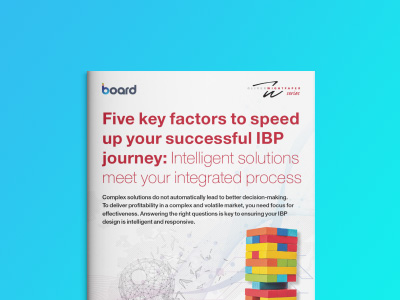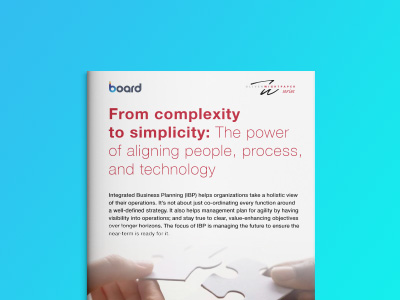
Advancing beyond S&OP: Is IBP the right approach for you?
As businesses mature and markets fluctuate, the need for adaptable planning processes increases. Transitioning from…

In today’s dynamic business landscape, conventional planning processes riddled with departmental silos often hinder visibility and efficiency. However, a transformative shift is underway. Forward-thinking companies are embracing digital transformation and adopting Integrated Business Planning (IBP) to empower their activities with enhanced coordination and collaboration. This blog delves into the definition of IBP and explores the substantial benefits it’s brings to organizations in a modern setting.
IBP is considered a best practice approach that seamlessly integrates financial and operational data from across the organization. This strategic method allows companies to optimize their output by connecting strategic plans with sales, operational, and financial plans. The result is enhanced visibility of the intricate relationships between resources, capabilities, and results. Through IBP, organizations collectively develop a comprehensive go-to-market plan that reflects contributions from every department.
IBP establishes a framework to achieve the following key goals:
IBP consists of a series of interconnected processes that work together to create a unified business plan:
IBP offers a multitude of advantages, including:
While IBP requires a mature planning process with the right technology and tools, successful implementation also depends on strong leadership, clear communication, and a collaborative culture across all levels of the organization. It’s a strategic approach that, when executed well, can significantly enhance a company’s performance and competitive edge.
Conventional planning activities are often disjointed, especially across the supply chain. The use of disparate spreadsheets and standalone business intelligence solutions creates isolated pockets of knowledge, hindering a holistic approach to planning. While some firms implement Sales and Operations Planning (S&OP) principles, true unification across the entire organization remains elusive. This fragmented approach leads to inefficiencies and suboptimal performance due to:
Overcoming these challenges requires a shift towards a unified planning process. IBP offers a comprehensive framework that breaks down departmental silos, integrates financial and operational data, and fosters a culture of collaboration. By implementing IBP, organizations can gain a clear view of their business, make better decisions, and achieve their strategic objectives.
IBP and S&OP are both strategic processes used by companies to align various functions within the organization. While they share similarities in aiming to improve business performance through better planning and alignment, there are distinct differences in scope, focus, and depth.
Here’s a comparison between the two:
| Feature | IBP | S&OP |
| Scope |
Integrates ALL business planning processes, including:
|
Focuses primarily on supply chain operations, including:
|
| Focus | Strategic & Long-term (24-36 months): Aligns operational plans with strategic goals & financial objectives. Considers long-term market trends and uncertainties. Sets the overall direction for the business. | Tactical & Operational (typically 12 months): Aims to balance supply & demand in the short to medium term. Focuses on efficiency and meeting near-term targets. |
| Financial integration |
Explicitly integrates financial planning with operational planning, ensuring all plans are financially viable. Financial metrics are a core consideration in decision-making. Drives profitability and return on investment (ROI). | Primarily focused on budgeting and operational costs. Financial viability is a consideration but not the core focus. Cost reduction and expense management are key objectives. |
| Decision-making levels | Supports strategic decision-making at all levels (overall business performance, strategic investments, market positioning). Empowers executives, managers, and cross-functional teams. Provides a holistic view of the business for informed decision-making. | Facilitates operational-level decision-making (optimizing supply chain activities to meet anticipated demand). Primarily used by supply chain managers and production planners. Focuses on short-term resource allocation and scheduling. |
IBP builds upon the foundation of S&OP. It extends the principles of supply chain alignment to encompass broader financial and strategic planning. While both processes are valuable, IBP offers a more holistic and future-oriented approach for businesses seeking to optimize performance across the entire organization.
Automating 90% of financial data input, slashing data transfer time from 24 hours to 15 minutes, and enabling digital, driver-based planning from production to delivery.
Coca-Cola European Partners (CCEP) leveraged IBP to transform their supply chain finance function. They implemented driver-based planning, which integrates financial and operational data, enabling them to make data-driven decisions and optimize resource allocation. IBP also improved collaboration across departments by providing a single platform for all users to access and analyze data.
This resulted in:
Overall, IBP increased transparency, streamlined processes, and empowered informed decision-making at CCEP.
The era of disjointed planning processes is giving way to the transformative power of IBP. Companies adopting it can unlock improved visibility, collaboration, and efficiency—setting the stage for sustained success in today’s rapidly evolving business landscape.
For further insights, explore our complimentary whitepapers and reports on the benefits of an IBP process.
 |
The 2024 Intent Group Guide on IBP | A comprehensive resource you need if you are considering adopting Integrated Business Planning in your organization. It helps planners evaluate the challenges and benefits of IBP implementation. |
 |
Five key factors to speed up your successful IBP journey | This co-authored report with IBP implementation experts, Oliver Wight, outlines five key steps to enable a more sophisticated and cost-effective IBP integration. |
 |
IBP. From complexity to simplicity: The power of aligning people, process, and technology | Whitepaper exploring the end-to-end service co-designed by Board and Oliver Wight, offering management teams an effective IBP architecture. |
A comprehensive resource for organizations considering Integrated Business Planning